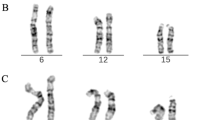Abstract
Single copies of tiny chromosome fragments, appearing as double minutes, were observed in a high proportion of cells from amniotic fluid cultures of two mothers undergoing prenatal testing because of advanced age. We applied a laser-based chromosome microdissection method to diagnose the origin of the double minutes. The diagnostic procedures consisted of microdissection of double minutes from a single cell, polymerase chain reaction (PCR) amplification of the dissected DNA, and subsequent fluorescence in situ hybridization (FISH) using the PCR products as a probe pool. Metaphase chromosomes from the patients' cells and from a karyotypically normal individual were probed. Using this strategy, we were able to determine that the double minutes originated from the centromere of chromosome 13 or 21 in one case, and from the chromosome 12 centromere in the other. The characterization of such double minutes helps both in the delineation of the nature of these epichromosomal bodies in normal individuals as well as in the clarification of genetic counselling issues.
Similar content being viewed by others
References
Blennow E, Telenius H, De Vos D, Larsson C, Henriksson P, Johansson O, Carter N, Nordenskjold M (1994) Tetrasomy 15q: two marker chromosomes with no detectable alpha satellite DNA. Am J Hum Genet 54:877–883
Buckton KE, Evans HJ (1982) Human peripheral blood lymphocyte cultures: an in vitro assay for the cytogenetic effects of environmental mutagens. In: Hsu TC (eds) Cytogenetic assay for environmental mutagens. Allnheld, Osmun, pp 183–202
Crolla JA, Dennis NR, Jacobs PA (1992) A non-isotopic in situ hybridization study of the chromosomal origin of 15 supernumerary marker chromosomes in man. J Med Genet 29:699–703
Haaf T, Schmid M (1988) Analysis of double minutes and double minute-like chromatin in human and tumor cells using antikinetochore antibodies. Cancer Genet Cytogenet 30:73–82
Haaf T, Warburton P, Willard H (1992) Integration of human alpha satellite DNA into simian chromosomes: centromere protein binding and disruption of normal chromosome segregation. Cell 70:681–696
Hadano S, Watanabe M, Yokoi H, Kogi M, Kondo I, Tsuchiya H, Kanazawa I, Wakasa K, Ikeda JE (1991) Laser microdissection and single unique primer PCR allow generation of regional chromosome DNA clones from a single human chromosome. Genomics 11:364–373
Hahn P (1993) Molecular biology of double minute chromosomes. BioEssays 15:477–484
Hamkalo B, Farnham P, Johnston R, Schimke R (1985) Ultrastructural features of minute chromosomes in a methotrexate-resistant mouse 3T3 cell line. Proc Natl Acad Sci USA 82:1126–1130
Johnson D, Kroisel P, Klapper H, Rosenkranz W (1992) Microdis-section of a human marker chromosome reveals its origin and a new family of centromeric repetitive DNA. Hum Mol Genet 1:741–747
Levan N, Mandahl N, Bregula U, Klein G, Levan A (1976) Doublemin are not centromeric regions of the host chromosomes. Hereditas 83:83–90
Madhavi R, Guntur M, Ghosh R, Ghosh P (1990) Double minute chromosomes in the leucocytes of a young girl with breast carcinoma. Cancer Genet Cytogenet 44:203–207
Meltzer P, Guan XY, Burgess A, Trent J (1992) Rapid generation of region specific probes by chromosome microdissection and their application. Nat Genet 1:24–28
Nichols W (1970) Virus induced chromosome abnormalities. Annu Rev Microbiol 24:479–500
Ohta T, Tohma T, Soejima H, Fukushima Y, Nagai T, Yoshiura K. Jinno Y, Niikawa N (1993) The origin of cytologically unidentifiable chromosome abnormalities: six cases ascertained by targeted chromosome-band painting. Hum Genet 92:1–5
Sen S, Sen P, Mulac-Jericevic B, Zhou H, Pirrotta V, Stass S (1994) Microdissected double minute DNA detects variable patterns of chromosomal localizations and multiple abundantly expressed transcripts in normal and leukaemic cells. Genomics 19:542–551
Speevak M, Hunter A, Cox D, Wang HS (1989) The use of computer data base for storage and retrieval of detailed cytogenetic data. Karyogram 15:51–53
Tagarro I, Fernandez-Peralta A, Gonzalez-Aguilera J (1994) Chromosomal localization of human satellite 2 and 3 by a FISH method using oligonucleotides as probes. Hum Genet 93:383–388
Taub R, Kirsch I, Morton C, Lenoir G, Swan D, Tronick D, Aaronson S, Leder P (1982) Translocation of the c-myc gene into the immunoglobulin heavy chain locus in human Burkitt lymphoma and murine plasmacytoma cells. Proc Natl Acad Sci USA 79:7837–7842
Thangavelu M, Pergament E, Espinosa R, Bohlander S (1994) Characterization of marier chromosomes by microdissection and fluorescence in situ hybridization. Prenat Diagn 14:583–588
Trowell H, Nagy A, Vissel B, Choo KHA (1993) Long-range analyses of the centromeric regions of human chromosomes 13, 14 and 21: identification of a narrow domain containing two key centromeric DNA elements. Hum Mol Genet 2:1639–1649
Voullaire L, Slater H, Petrovic V, Choo KHA (1993) A functional marker centromere with no detectable alpha satellite, satellite III, or CENP-B protein: activation of a latent centromere? Am J Hum Genet 52:1153–1163
Wahl GM (1989) The importance of circular DNA in mammalian gene amplification. Cancer Res 49:1333–1340
Wang HS, Bellinger J, Brierley K, Dawson L, Goldsmith C, Hunter A (1994) Minute chromatin structures in cells of amniotic fluid: an interpretive dilemma. Prenat Diagn 14:868–872
Wevrick R, Earnshaw W, Howard-Peebles P, Willard H (1990) Partial deletion of alpha satellite DNA associated with reduced amounts of the centromere protein CENP-B in a mitotically stable human chromosome rearrangement. Mol Cell Biol 10:6374–6380
Author information
Authors and Affiliations
Rights and permissions
About this article
Cite this article
Rajcan-Separovic, E., Wang, HS., Speevak, M.D. et al. Identification of the origin of double minutes in normal human cells by laser-based chromosome microdissection approach. Hum Genet 96, 39–43 (1995). https://doi.org/10.1007/BF00214184
Received:
Revised:
Issue Date:
DOI: https://doi.org/10.1007/BF00214184




